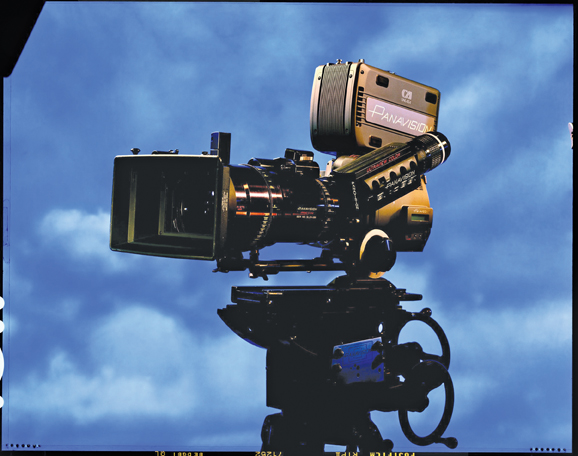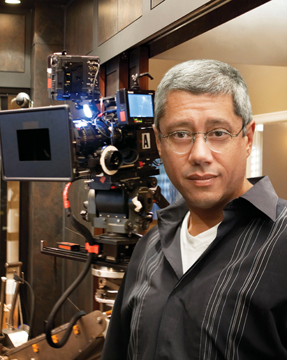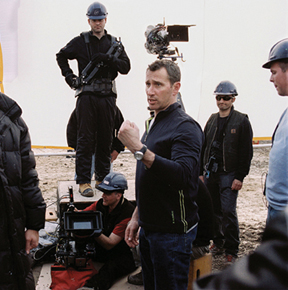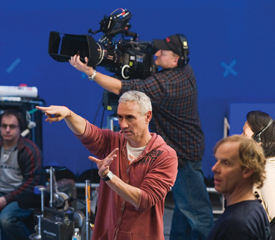BY DANIEL FRANKEL

 Panavision's Genesis and the
Panavision's Genesis and the
independently made RED ONE."I don’t think I will ever go back,” says Roland Emmerich, who saw his celluloid world come to an end with 2012, which he shot primarily with Panavision’s Genesis high-definition camera.
“What I love about RED is you give them a hurdle and they respond,” says David Fincher, who is shooting his next feature, the Facebook biopic The Social Network, with a RED ONE, a low-cost camera made by a start-up company funded by a billionaire sunglasses mogul.
Indeed, with about 20 percent of studio features now being shot with digital cameras—the number is much higher for TV and commercial production—the Genesis and the RED ONE have emerged from a morass of early product offerings to become leaders of this still-developing market.
That’s not to say that there aren’t plenty of other digital competitors vying for the high-end TV and film production users nearly a decade after George Lucas kicked off the digital camera revolution by using a Panavision-modified Sony HDW-F900 camera to shoot his second Star Wars prequel.
For example, Michael Mann used Sony’s CineAlta F23 and HDC-F950 cameras on Public Enemies. And the Thomson Viper remains a popular choice, too. It was used, along with Sony’s F23, on Matt Reeves’ 2008 sci-fi film Cloverfield. Among entries from companies newer to the market, there’s Silicon Imaging’s small SI-2K, which was used on Danny Boyle’s Slumdog Millionaire, winner of last year’s Oscar for best cinematography.
And Vision Research’s high-speed Phantom HD, which is especially adept at slow-motion shooting, is carving a niche in commercial production. “A simple, mundane thing like pouring water into a glass takes on an extraordinary beauty when you slow it down to 1,000 frames a second,” says Moe Shore, a product manager for the Phantom line. “To do that with film would require an enormous camera and cost.”
Still, among directors and cinematographers these days, the most excitement—and polarizing discussion—probably surrounds the tape-driven Genesis and the hard drive-based RED ONE.
“Both cameras have their pros and cons,” notes Dean Devlin, director and producer of the cable series Leverage. “The advantage of the Genesis is that it’s a rock-solid camera, made by a company with an enormous history and a huge support base. Plus it’s very good in low light using all the Panavision lenses. The downside is that you’re recording on tape. The RED has the same advantage as far as excellent lenses, but the downside is that it’s from a company that’s just a few years old, and there are still lots of bugs.”
In terms of their most basic technology, the RED and the Genesis are similar in that they both employ a single charge-coupled device (CCD) imaging chip that is the same width as a 35 mm film frame. Unlike digital cameras from companies rooted in broadcast television that use three CCD imaging systems that are 2/3-inch wide, the single-chip Genesis and RED ONE are compatible with most standard spherical film lenses.
“That’s one of the best things about the RED ONE—I can use all the best lenses that have been used in film forever,” says Devlin, whose production company, Electric Entertainment, has planned its entire production slate in film and TV using the RED camera.
But while the Genesis and the RED share key similarities in their ability to fit nicely into a world still shaped by 35 mm film, the lineage and business models of the two cameras could not be more diametrically opposed. On the one hand, Panavision is a 56-year-old, Southern California-based camera manufacturer with deep roots in film and TV production. According to Andy Romanoff, the company’s executive vice president of technical marketing and strategy, “Panavision has its feet planted on both sides of the water,” with digital and traditional cameras. The Genesis has so far been used to produce about 140 feature films, including Tim Burton’s upcoming Alice in Wonderland and Ruben Fleischer’s Zombieland.
Infused with key components developed by Sony, including a 12.4 megapixel, RGB-filtered CCD—one of the more advanced chips ever made for reproducing film-like resolution and color—as well as a tape-based HDCAM-SR digital storage system, the Genesis is among the premium digital cameras on the cinema-grade market.
In keeping with the business model established decades ago by Panavision and Arri, the Genesis isn’t sold; it’s rented, at a rate of $3,500 a day to $45,000 a week, depending on the number of cameras and lenses. Its lofty price has confined it to the upper echelon of the film and TV market. Not a lot of low-budget independent projects use the Genesis, but its Panavision pedigree has conveyed a degree of trust to veteran filmmakers curious about taking the digital plunge.



 THE BIG PICTURE: (top to bottom)
THE BIG PICTURE: (top to bottom)
Dean Devlin, Adam Shankman, David
Fincher, and Roland Emmerich.
(Photo: Virginia Sherwood/NBC Universal)Adam Shankman had heard many of the cautionary stories about digital cameras before he was strongly encouraged by the film’s star Adam Sandler to shoot
Bedtime Stories two years ago with a Genesis. Sandler is a big believer that the let-the-camera-just-roll ethos of digital shooting enhances comedic filmmaking. “Adam loves it. He likes to adjust stuff within the take. But I was very, very leery,” admits Shankman. “I was very worried about the depth of field, and for the first two weeks, I really had my eye on it because I was concerned after I saw testing of the daytime exteriors.”
Shankman, who has directed color-saturated movies like Hairspray and The Wedding Planner, was still very much a true believer in traditional celluloid, so having the Panavision brand on the camera made the switch to digital a bit less nerve-racking for him.
“Everything ended up being just fine,” he reports. “It helps when you have a DP who really understands the camera, but frankly, [the Genesis] was easy to work with... and kind of fun. You can do color enhancement on the spot.”
Adds Emmerich, who used the Genesis for the first time on 2012: “I’m always nervous about electronics anyway, but we had so many effects shots and so much blue screen that we absolutely wanted to use a digital camera. Compositing is so much better in digital—there’s much more information to work with.”
In making the transition to digital, Emmerich found a trusted hand in cinematographer Dean Semler, who had already used the Genesis on Mel Gibson’s Apocalypto. “Dean has proven again and again that he can make digital look close to film, and that’s what counts,” Emmerich notes. “Most people would never know 2012 was shot in digital.”
While the Genesis is finding supporters among established filmmakers who put a lot of faith in their camera people to handle technical nuance, the RED camera has approached the market from the opposite side of the spectrum, captivating hands-on early adopters. Based in Northern California and founded by Oakley mogul Jim Jannard in 1999, the RED Digital Cinema Camera Company has priced its fast-evolving 4K product to sell at $17,500. According to the camera rental shop, Abel Cine Tech, the RED ONE ends up running about $35,000-$40,000, including lenses, accessories and insurance. Over the course of a single 20-40-day shoot, that’s cheaper than film and digital cameras from more established manufacturers that can run up to $4,000 a day to rent.
Unlike the tape-driven Genesis, the RED employs a hard-disk storage system and has proliferated in the independent film ranks both at home and abroad. But the RED’s revolutionary sell-through business model has irked rental-based competitors, with one official for a rival manufacturer saying, “The idea that buying a camera sets you free is somewhere between naïve and disingenuous. Own it, and you store it and you insure it and you watch it go obsolete.”
Nonetheless, the RED ONE is now starting to infiltrate the high-end of the market as well, with filmmakers and TV producers, including Fincher, Steven Soderbergh and John Wells lauding the RED for its responsiveness and engineering savvy.
Fincher is a prime example. “I’ve shot with most of the cameras that are out there,” Fincher says. “We’ve also looked closely at [a camera made by] Dalsa and a couple of other companies that are out of the business now.”
He shot 2007’s Zodiac with a Thomson Viper, then used a Sony CineAlta F23 for last year’s The Curious Case of Benjamin Button, and reports having a better experience with the RED.
A filmmaker who delivers plenty of feedback to his camera supplier, Fincher grew frustrated by Thomson. “I got very involved with them, but we would generate list after list of things they needed to think about going forward, and all we would get is lip service,” he notes. “Nothing ever happened, and that’s a real problem with an emerging technology.”
He then checked out the Genesis. “I took one look at the Genesis and thought, ‘Why is there a tape recorder stuck to the top of the camera?’ We’re working with digital media now—we want hard drives.”
But Fincher is effusive in his praise for RED, noting that when his crew needed to reduce the size and weight of the ONE for a scene in The Social Network, within a three-day span the company delivered not one, but two lighter, smaller versions made out of carbon fiber.
Meanwhile, Devlin has made the RED ONE a central component of Leverage, a show that incorporates myriad digital effects sequences on a lean budget. “For me, those very easy-to-change hard drives are a big deal,” Devlin says. “They store an enormous amount of material, and we can just take them and immediately put them into our system and get right to work. That transcends everything—skipping the transfer of dailies is a game-changer.”